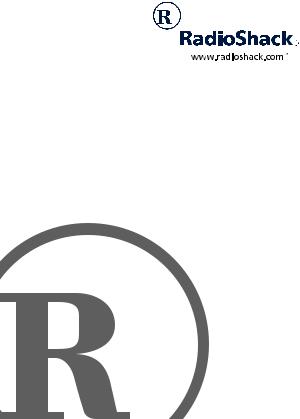Radio Shack Weather Radio User Manual

7-Channel Portable SAME Weatheradio®
with Alert
Owner’s Manual |
Please read before using this equipment. |

ˆ Contents |
|
Features ................................................................. |
5 |
How Your Radio Works ......................................... |
6 |
Weather Alerts ................................................. |
7 |
New Alert Types ........................................ |
8 |
Understanding FIPS Codes ............................. |
8 |
Obtaining Your Area’s FIPS Code(s) ........ |
9 |
Preparation .......................................................... |
11 |
Installing Batteries .......................................... |
11 |
Using the Antenna ......................................... |
12 |
Programming ....................................................... |
13 |
Missed Alert Reminder Beep ......................... |
17 |
Enabling/Disabling the Alert Tone .................. |
18 |
Testing the Weatheradio ................................ |
20 |
Manually Testing the Alert Tone .............. |
21 |
Using the Weatheradio’s ‘All Signals’ Code ... |
22 |
Operation ............................................................. |
23 |
The Display Backlight ..................................... |
23 |
Listening to Broadcasts .................................. |
24 |
Using the Alert Function ................................. |
24 |
When a Weather Alert Occurs ................ |
25 |
© 1999, 2000 RadioShack Corporation.
All Rights Reserved.
Weatheradio is a registered trademark used by RadioShack Corporation.
2

Reviewing Overlapping Alerts ................ |
26 |
When a Test or Demo Alert Occurs ........ |
26 |
Alert Descriptions ............................................... |
28 |
Troubleshooting ................................................. |
32 |
Care ............................................................... |
34 |
Specifications ..................................................... |
35 |
ˆ FCC Information
This device complies with Part 15 of the FCC Rules. Operation is subject to the following two conditions:
(1) this device may not cause harmful interference, and (2) this device must accept any interference received, including interference that may cause undesired operation.
|
|
|
|
|
Product: |
7 Channel SAME Weatheradio with Alert |
|
|
Model: |
12-254 |
|
|
Responsible |
RadioShack |
|
|
Party: |
100 Throckmorton |
|
|
|
Fort Worth, TX 76102 |
|
|
Phone: |
817-415-3200 |
|
|
|
|
|
3

This equipment has been tested and found to comply with the limits for a Class B digital device, pursuant to Part 15 of the FCC Rules. These limits are designed to pro-
vide reasonable protection against harmful interference in a residential installation. This equipment generates, uses and can radiate radio frequency energy and, if not installed and used in accordance with the instructions, may cause harmful interference to radio communications.
THE FCC WANTS YOU TO KNOW
Your Weatheradio might cause TV or radio interference even when it is operating properly. To determine whether your Weatheradio is causing the interference, turn off your Weatheradio. If the interference goes away, your Weatheradio is causing it. Try to eliminate the interference by moving your Weatheradio away from the TV or other radio.
4

ˆ Features
Your RadioShack Weatheradio represents the latest generation of weather alert technology. Your Weatheradio uses SAME (Specific Area Message Encoding) circuitry to provide more complete information about weather conditions in your immediate area, letting you avoid hearing alerts for geographical areas that do not affect you.
SAME Operation — lets you program up to 15 different FIPS (Federal Information Processing System) codes into the Weatheradio’s memory so your Weatheradio sounds an alert only when a weather emergency is declared in those locations.
Display Backlight — makes the display easy to read in low light situations.
Missed Alert Reminder Beep — assures you that you do not miss an important weather alert by continuing to sound a chirp tone until the alert time expires.
Features |
5 |

ˆ How Your Radio Works
Traditional weather radios simply receive the National Oceanic and Atmospheric Administration (NOAA) weather broadcast (usually within a 50-mile radius) then sound an alarm if an emergency code was transmitted along with the broadcast. This means that people who live outside an affected area are often alerted even when their area is not affected, causing many of them to ignore potentially real weather warnings that can save lives.
In 1994, NOAA began broadcasting coded signals called FIPS (Federal Information Processing System) codes along with their standard weather broadcasts from stations in your area. These codes identify the type of emergency and the specific geographic area (such as a county) affected by the emergency. Your Weatheradio receives, interprets, and displays information about the codes so you can determine if the emergency might affect your area. Only SAME compatible weather radios (such as this Weatheradio) are able to take advantage of this new technology.
Each FIPS code identifies a specific geographic area (defined by the National Weather Service), so your
6 |
How Your Radio Works |

Weatheradio sounds an alert only when a weather emergency is declared in that area. This helps you more efficiently track the weather conditions in and around your area.
WEATHER ALERTS
When the Weatheradio receives a weather alert:
•it sounds an alert beep
•it displays a description of the alert and the alert duration
Note: If the Weatheradio receives more than one weather alert at the same time, it displays information for each alert in sequence.
The alert descriptions your Weatheradio can display are based on a list of specific weather alert types published by the NWS. For a list of all the alert descriptions that your Weatheradio can display, see “Alert Descriptions” on Page 28.
Warning: The NWS uses sophisticated weather models to determine an alert’s effective time. However, the end of an alert does not necessarily mean that the related weather emergency is over.
How Your Radio Works |
7 |

New Alert Types
Your Weatheradio is designed to recognize all common weather alert types currently used by the NWS. However, the NWS occasionally creates and broadcasts new alert types (for which the Weatheradio’s memory does not contain a specific, corresponding description). If your Weatheradio receives a signal for
a new alert type, it is preset (if the alert function is turned on) to display 81.12:1, the alert description, ((0(5*(1&, 67$7(017, :$51,1*, or :$7&+), and 781( 79,
then sound a beeping alert.
UNDERSTANDING FIPS CODES
For the purpose of broadcasting weather information, the NWS has divided the United States into regions by state and county (or parish, where applicable) then assigned a 6-digit FIPS code to identify each county or parish. For example, the code for Tarrant County, Texas, is 048439.
The first digit in a FIPS code identifies the county subdivision, the next two digits identify the state, and the last three digits identify the county or parish.
Note: Most FIPS codes begin with 0, which means the code represents an entire county. The NWS, how-
8 |
How Your Radio Works |

ever, plans to eventually subdivide some large counties. When that happens, each subdivision will be assigned a digit from 1–9, resulting in codes such as 148439, 248439, and so on.
Your Weatheradio can receive all SAME alert signals broadcast within about a 50-mile radius of where you installed it. To receive SAME alerts and broadcasts about weather occurring only in particular counties within that area, you can program up to 15 FIPS codes into the Weatheradio’s memory. For example, this lets you avoid hearing an alert that applies to an area within a 50-mile radius but not necessarily to your county or parish.
Obtaining Your Area’s FIPS Code(s)
To obtain the FIPS code for the location where you installed your Weatheradio, contact your local RadioShack store or call the NWS toll free at 1-888- NWR-SAME (1-888-697-7263). If you call the NWS, follow the instructions you hear.
You can also obtain a state/county list of all FIPS codes by visiting the NWS website:
www.nws.noaa.gov/nwr/
indexnw.htm#sametable
How Your Radio Works |
9 |

Note: If you are close to a county or parish line, you might want to obtain the codes for the nearby counties or parishes.
Hint: Since you can program up to 15 FIPS codes into the Weatheradio’s memory, you might want to obtain the codes for other local areas that you frequently travel through (as long as those areas are within a 50 mile radius of your location and within an area covered by your local NWS broadcast station). That way, you can program those codes into the Weatheradio and receive broadcasts covering those locations, too.
10 |
How Your Radio Works |

ˆ Preparation
INSTALLING BATTERIES
Your radio uses three AA batteries for power. For the best performance and longest life, we recommend RadioShack alkaline batteries.
Warning: Dispose of old batteries promptly and properly; do not bury or burn them.
Cautions:
•Use only fresh batteries of the required size and recommended type.
•Do not use rechargeable batteries in your Weatheradio.
•Never leave weak or dead batteries in the radio. They can leak chemicals that can damage the radio.
•If you do not plan to use your radio for several weeks, remove the batteries.
Preparation |
11 |
